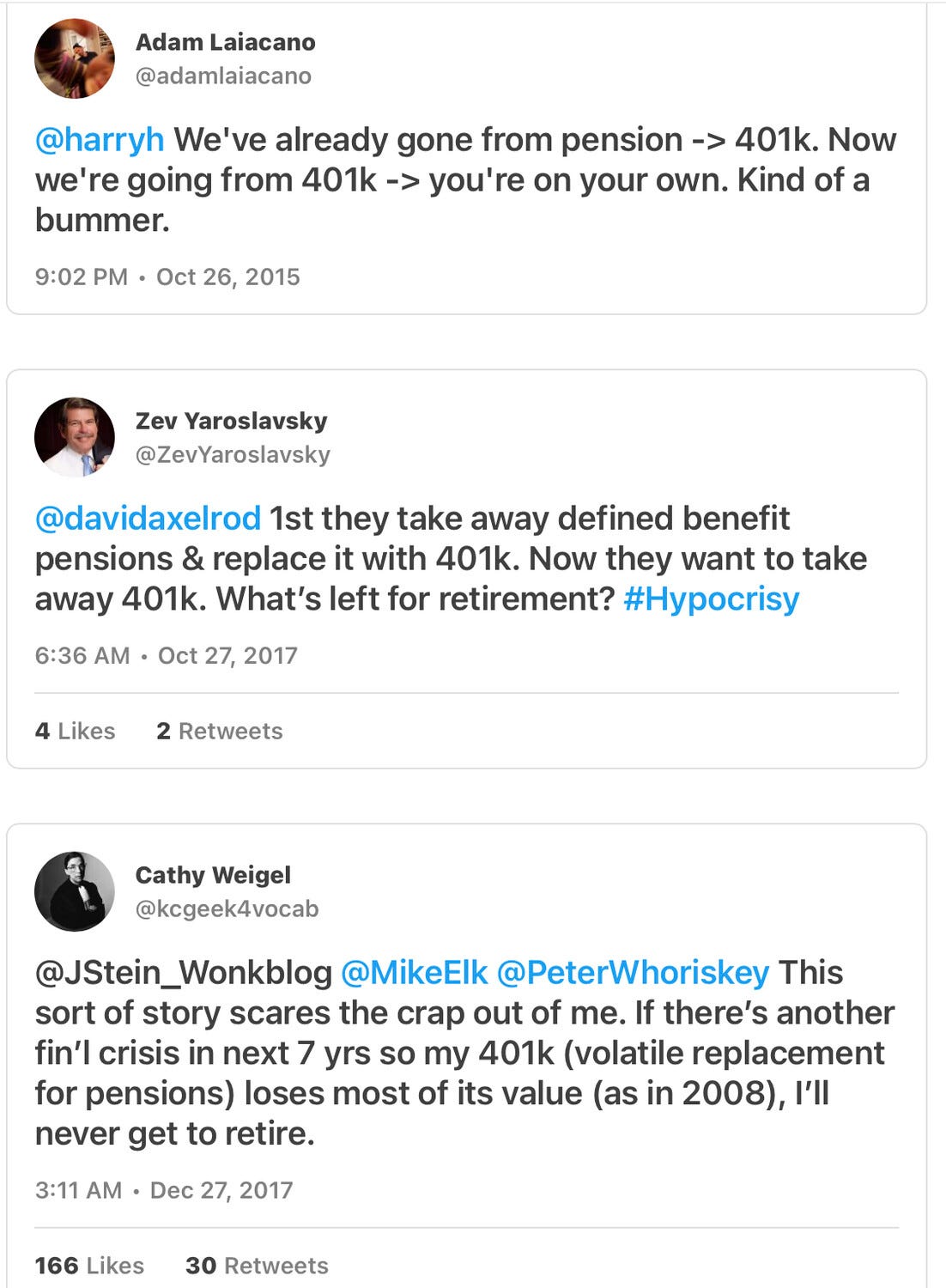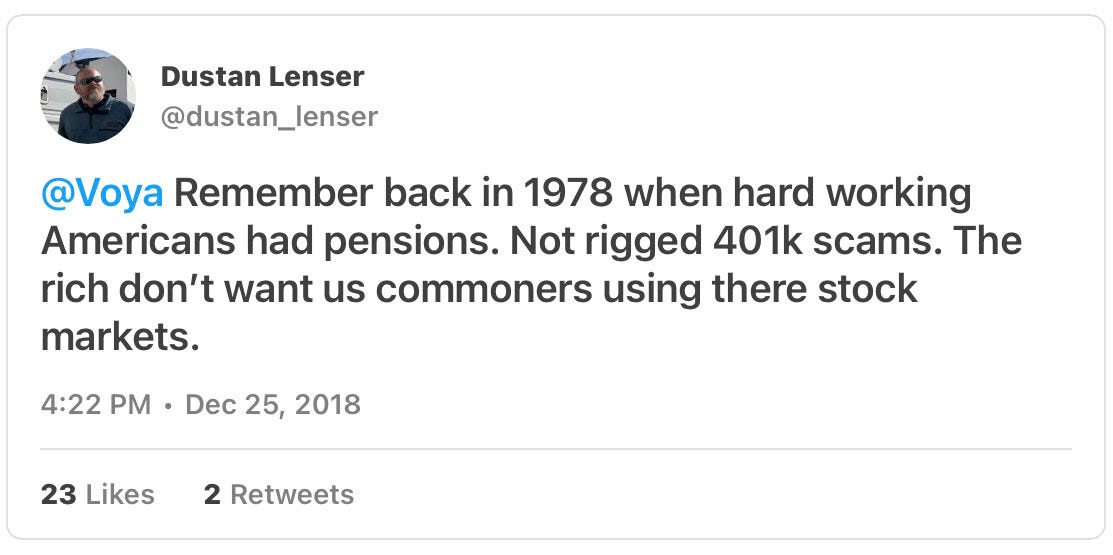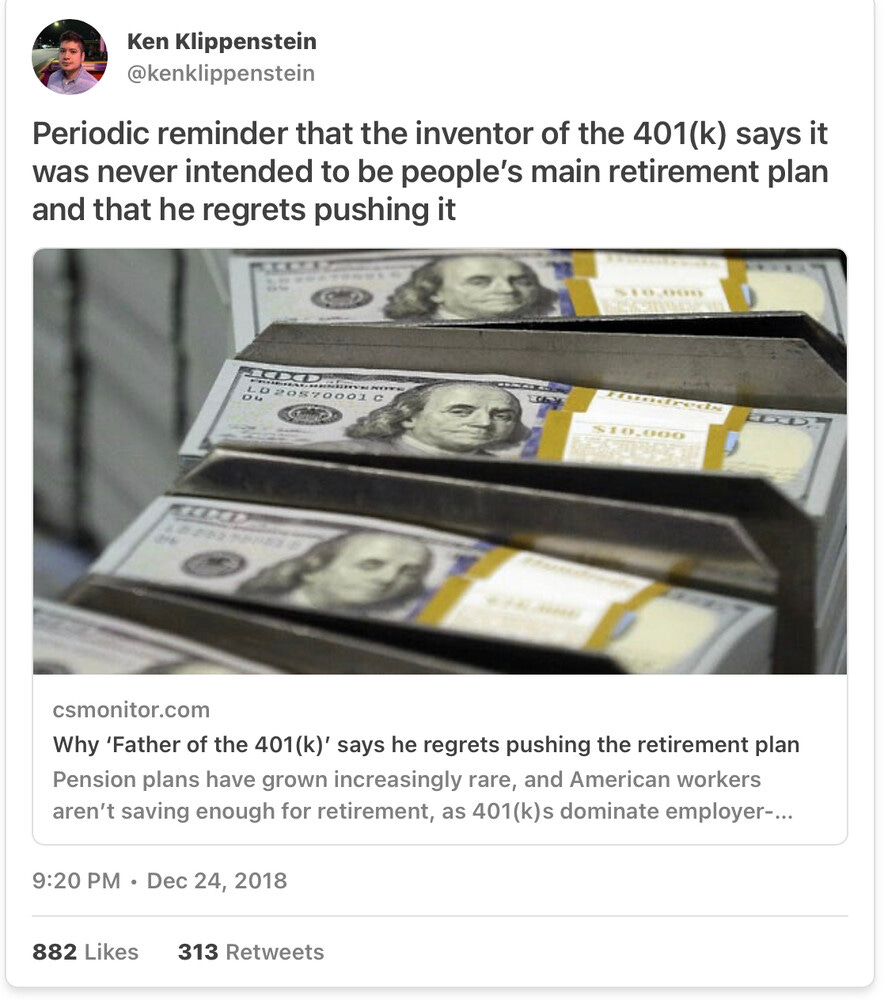Fintech Horror Stories - From the Archives: Pensions -> 401K Deep Dive
History, Data, Sentiment and Fintech Solutions
Today’s piece is from the archives, something I authored a few years ago in the earlier incarnation of this newsletter. Interestingly (and sadly), two of the five fintechs highlighted in this topic no longer exist or have been acquired. Catch shut down last month, and Blueprint Income was acquired by MassMutual although it still lives on under its parent company. Worth thinking about what this says about the points raised at that time, when money was flush and investors were excessively positive.
As mentioned a few weeks ago, I’m out of the country and occupied in observing Ramadan so I’m getting takes from my past and from friends/fellow enthusiasts. If you want to learn more about what I’m up to in Ramadan, click here. Thank you. Now, let’s go back in time:
People get old and decide they no longer want to exert themselves in labor. That has been an age-old (no pun intended) truth. To facilitate this desire, pensions have been around in some way, shape, or form for thousands of years. Regardless of what form these took, through pensions there was always an expectation that the employer would provide for the employee, whether by safeguarding an employee’s own defined contributions, outright providing on top of the existing salary, or doing something else. In the last one hundred years, particularly the last fifty years, this has become more complicated than ever, with new vehicles entering the fray, like the 401(K), and the players that involved in the average worker’s retirement expanding beyond the employer to include investors/markets, the government, and of course, fintechs, which is why you’re here. In today’s Event Horizon, we put in some time and research and will look at 1) the rise in popularity of pensions, particularly in the US as a result of the New Deal and associated programs 2) their downfall in the ‘80s and ‘90s and eventual supplanting by 401(K)s and reasons why along with data/analysis 3) some worker perspectives on the matter 4) notable fintechs that are trying to solve some of the issues noted.
The Rise of Pensions
Public pensions have been a thing since the days of the Roman Empire, coming into common practice in the 1800s. Private employers began to offer these as well, buoyed by the Revenue Act of 1913 and specifically an IRS Treasury Department ruling in the year that followed, which stated “Amounts paid for pensions to retired employees or to their families or others dependent upon them…are proper deductions as ordinary and necessary expenses. Such deductions are limited to the amount not compensated for by insurance or otherwise. No deduction shall be made for contributions to a pension fund held by the corporation, the amount deductible in such case being the amount actually paid to the employee.” Deduction occurring on the payouts of these pensions, which up to that point had not been clear. The subsequent Revenue Act of 1921 established that stock dividends “shall not be subject to tax but…the amount received in redemption or cancellation of the stock shall be treated as a taxable dividend to the extent of the earnings or profits…”. The 1926 Revenue Act got even more specific and said “Gross income does not include the following items, which shall be exempt from taxation…pensions from the United States for service of the beneficiary” and “A trust created by an employer as part of a…pension...shall not be taxable under this section.” The government locked in the concept of state pensions permanently with Social Security, and things seemed to be on the up and up for the American worker’s retirement funding.
Trouble Arises, with data
However, with the creation of ERISA (Employees Retirement Income Act) in 1974, a number of requirements were added over pension plans, funding requirements were set, and the Pension Benefit Guaranty Corporation was established. This regulation was the direct result of the failure of Studebaker, an auto company, suddenly closing its auto plant and denying pensions for around 4,000 of its employees. On the surface, passing this regulation seemed like a great thing. In reality, it ended up being the genesis of the move away from private pension plans for most employers. A deep dive into the Department of Labor’s statistics since 1975 along with the St. Louis Fed’s Civilian Labor Force Level tracking revealed some interesting conclusions in the data:
Active pension plan participants in 1975 numbered 41.2% of the total labor force in the US. By 1984 they were at 54%. Since then, this figure has not surpassed 60%. Key to this is the passing of the Retirement Equity Act of 1984 and the Tax Reform Act of 1986. ERISA was enough to handle, but these two regulations were the nail in the coffin. Furthermore, from 1975-1984, active participants in Defined Benefit plans were generally increasing. In 1984, the active participants as an absolute number hit their peak at 24.2 million, after which they have fallen all the way to 8.4 million as of 2018.
Even assets in pension plans (whether defined benefit or defined contribution) were impacted; as they grew 117% between 1975 and 1980, and 122% between 1980 and 1985. Since 1985, the growth has been around 30-40% on average in the subsequent 5-year periods. Conversely, 401(K) assets grew 167% between 1985 and 1990, 124% between 1990-1995, and 100% between 1995-2000. While 401(k) performance has also slowed down to around the same average since 2000, this is due to the market influence and not due to slowing benefits/contributions (the primary driver for pensions).
Worker Perspectives
A great study was conducted by the National Bureau of Economic Research in 2011 entitled “FINANCIAL LITERACY AND PLANNING: IMPLICATIONS FOR RETIREMENT WELLBEING.” The issues with citizen financial literacy as a result of this survey indicated just why 401(k)s are not pensions - pensions had to be managed by the employer, purely everyone’s best interest, while 401(K)s are typically run directly by employees themselves, unless they opt for a third party to manage these assets (at a cost, which is borne by the employer and then essentially passed back to the employee).
Some great quotes also follow highlighting the sentiment over recent years:
Emphasis on the last tweet, with a link to the article.
Notable Fintechs
Who is out there trying to make sense of this situation? While it is true that the fintech industry has been panned as of late for seemingly having profit generation and funding as its primary goal, there are some players there trying to solve this problem and help workers manage their retirement assets in a way that tries to fill the void left by what pension plans used to do. I’ve linked to interview with leaders from each organization:
Catch (Kristen Anderson, CEO)
Blueprint Income (acq Mass Mutual -> Empower Retirement) (Matt Carey, CEO)
Simplywise (Profile on COO/CoFounder Allie Fleder)
Icon (Money 20/20 Pitch by Laurie Rowley, CEO)
While none of these purport to have all the answers, I took advantage of my Crunchbase Pro subscription and chose to highlight these five in particular. Whether it is trying to help navigate the existing system, come up with an alternative system, or provide a different approach on retirement asset management, these fintechs provide me some hope for the future and deserve your consideration and support. Let’s wish them the best.





